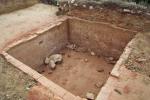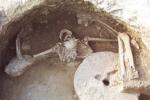Summary (English)
The site is located at the foot of the ‘Sierra de Segaria’, next to the Motorway A-7 Valencia-Alicante. The areas we are studying are bounded in the north and the west by Vinyals, in the east by private properties and in the south by Cremaelles ravine. In 2000, the urbanisation of the plots 188 and 189 were planned; they did not go fully ahead given the existence of the necropolis of Vinyals, identified during the environmental impact study for the Motorway A-7.. Therefore, it had not been possible to establish whether the archeological materials found in the plots relate to a site, or if they were produced by erosion or carried from a site located in the immediate surroundings.
To identify the nature of the materials, a substantial archaeological investigation was carried out based on 36 cores. We also cleaned and evaluated a furnace structure located within the plot. These plots were profoundly transformed in the 60s. The influence of the introduction of orange cultivation was enormous. Aggressive ploughing demanded heavy equipment, which impacted the surface layers and the bedrock, distorting the topography and the original archaeological substrate. The only archaeological remains documented were found in 7, 13, 23, 26, 28 and 36 drillings.
In the drillings of 6, 7 and 8, dark brown marks in the geological layer were excavated, taking advantage of a clay vein of a very plastic texture. there are 16 concrete marks, located in the middle of the plot, corresponding to an alignment of cuts in a narrow band, orientated east- west. Their diameters are different and vary from 1,10 to 1,80 m. Only the bottom or base coatings were preserved. The filling stratum is homogenous, with dark brown soil and a lot of gravel and pebbles.
This rich and homogeneous stratum had some materials we have been able to rescue, although highly fragmented, we believe they have a High-Imperial Roman chronology in the first and second centuries. Within silo 14 there is documentation of a human, the primary burial of an individual on its back with arms outspread and the legs bent and resting on a mill piece. As a result of the dismantling of the upper layers of the burial, the body has lost a part of the hip and the upper bones of the lower extremities.
In 36 a furnace was located, dated to the 18-19th centuries, already known of and documented. An area of 40 square meters was excavated to expose the external surface of the furnace. It is a structure for heat, excavated in the rock in such a way that it takes advantage of the left slope of the Cremaelles ravine. Its base is 2.60 by 2.60m, and 3.95m tall. It’s structure is split into two: the heat chamber and combustion chamber. Cleaning them, and their placement context, did not provide much in the way of information and thus made chronology and dating difficult. (Thankfully, though, it’s condition is exceptional and so its cataloguing and protection are vital).
(translation by Esther Casares Carmona)
- Marco Aurelio Esquembre Bebia
Director
- Marco Aurelio Esquembre Bebia
Team
- Museo Arqueológico de la Ciudad de Denia
Research Body
- Empresa arqueológica Arqueogestión
Funding Body
- Empresa Mercantil San Sebastián Seniorenresidenz S.A






![Download [PDF]](/excavation/skins/fasti/images/results/download_sml.png)
